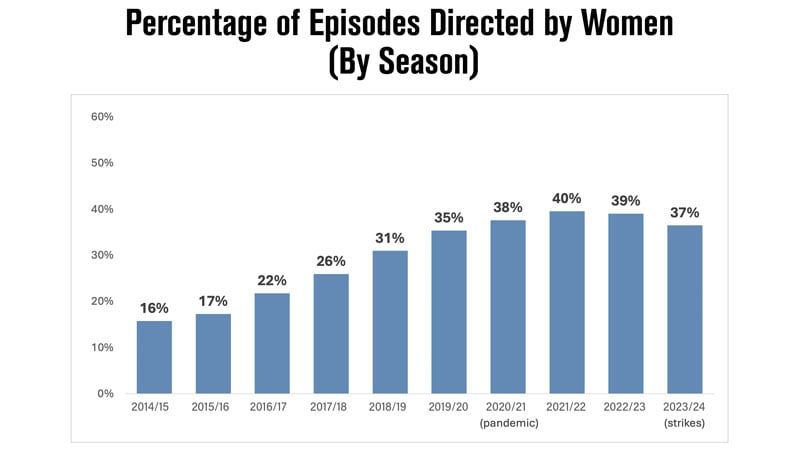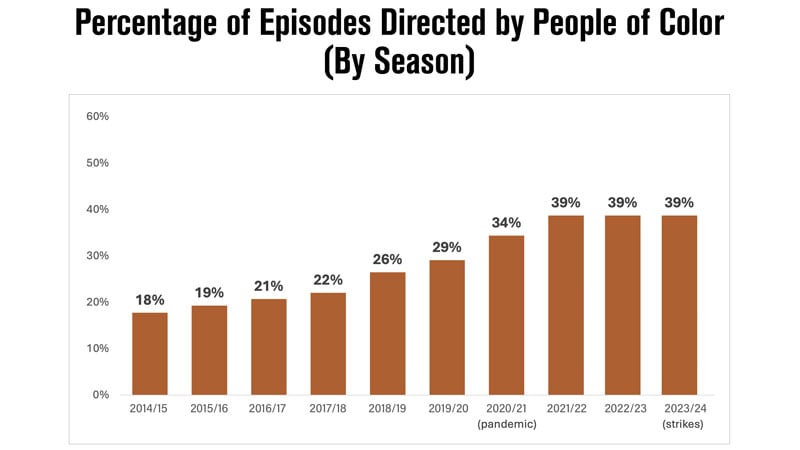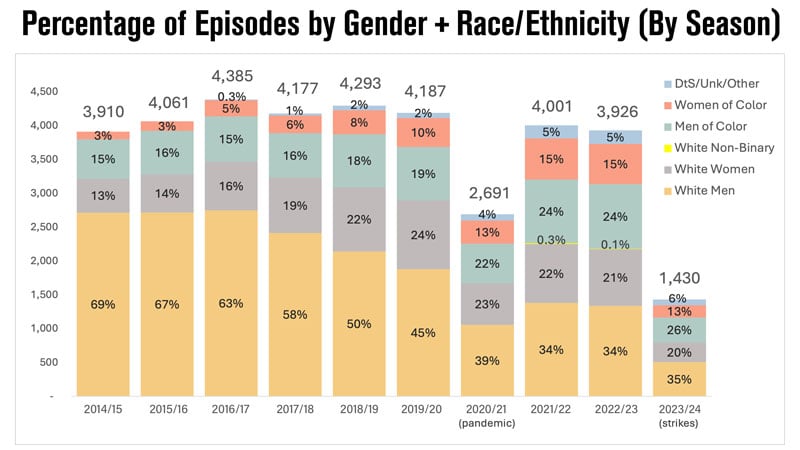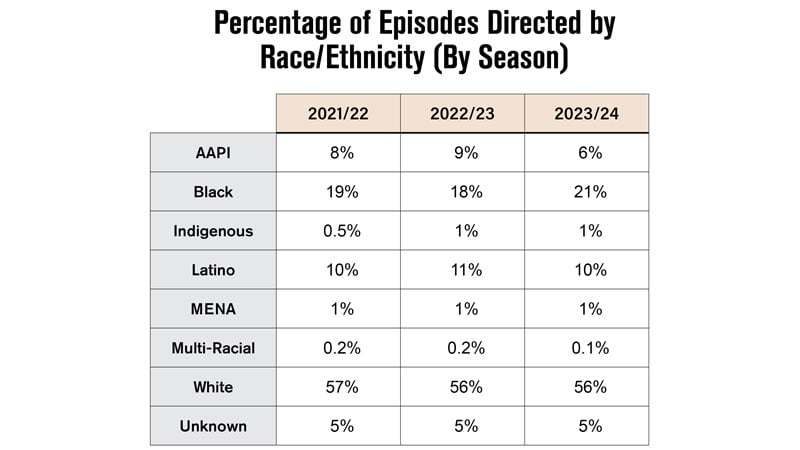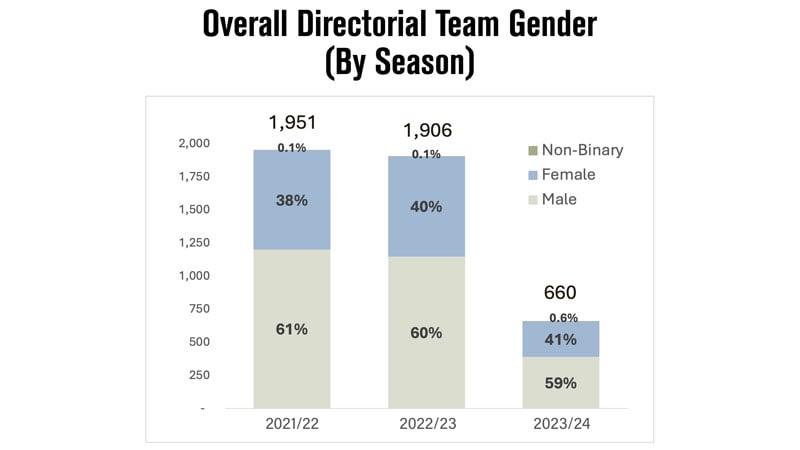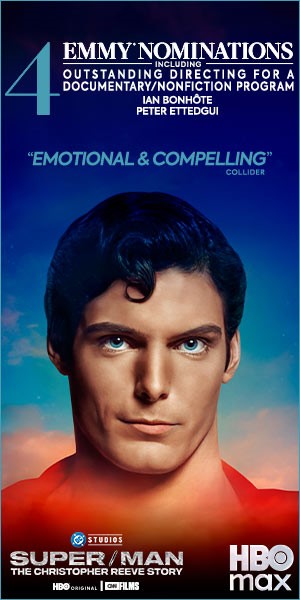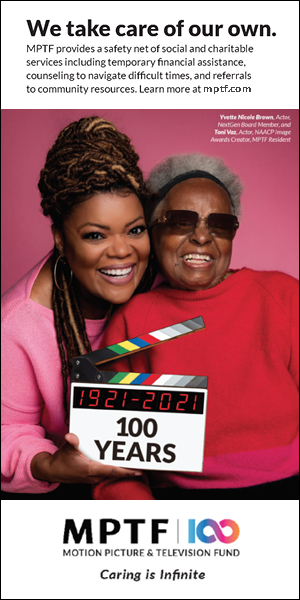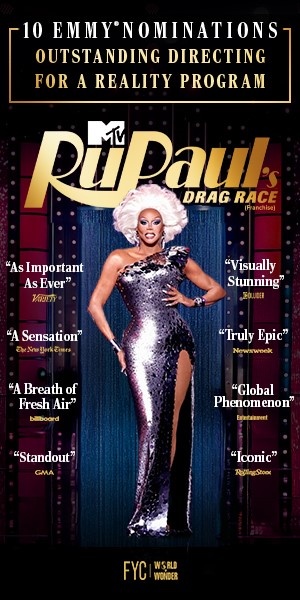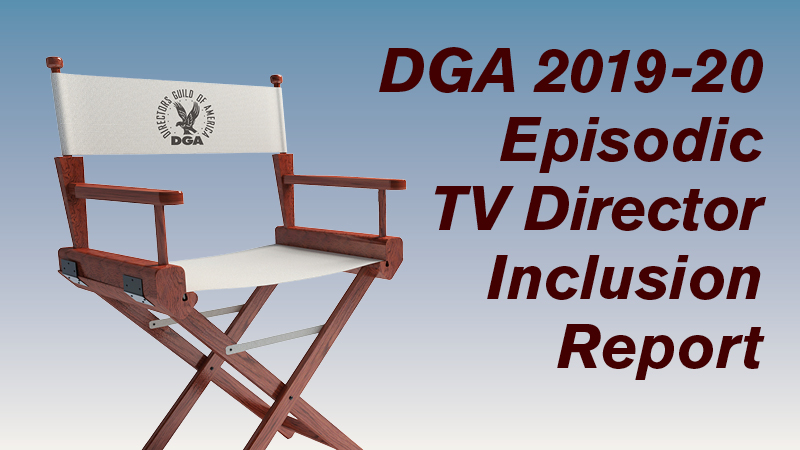Analysis of demographic hiring trends shows stable episodic television employment at studios and streamers for female Directors and Directors of color despite reduced production.
Report releases a first look at data for hiring among LGBTQ+ and disabled communities.
Despite gains for television Directors, inclusive hiring for members of the directorial team remains challenging.
Los Angeles – The Directors Guild of America (DGA) released today an analysis of hiring trends in episodic television for the 2023-2024 season, showing that recent gains over the past decade in employment levels for women and Directors of color have continued during the recent slowdown in television production.
The report also includes hiring data for women and people of color in the directorial teams, as well as initial data on the employment of Directors and members of the directorial team who self-identify as LGBTQ+ or as a person with a disability. The Guild began tracking this data in 2022.
“The good news is that the industry has made measurable gains in the employment of women Directors and Directors of color in episodic television over the past ten seasons,” said DGA President Lesli Linka Glatter. “Although these gains have held steady through the beginning of 2024, we must remain vigilant in this time when employers have pulled back on production. Our Diversity and Inclusion data is critical for putting pressure on the industry to do a better job in advancing opportunities for Directors from historically marginalized communities. So, we are proud to expand the reach of our data to also include trends for the LGBTQ+ and disabled communities as we continue our commitment to advocate for an equal playing field for all.”
Hiring of Television Directors
An analysis of 1,430 DGA-covered television episodes produced during the 2023-2024 season showed the percentage of all television episodes directed by women was 37%, which is up from 16% over the past ten years, but down 3% from its high in 2021, and 39% for those directed by people of color, which rose from 18% ten years ago.
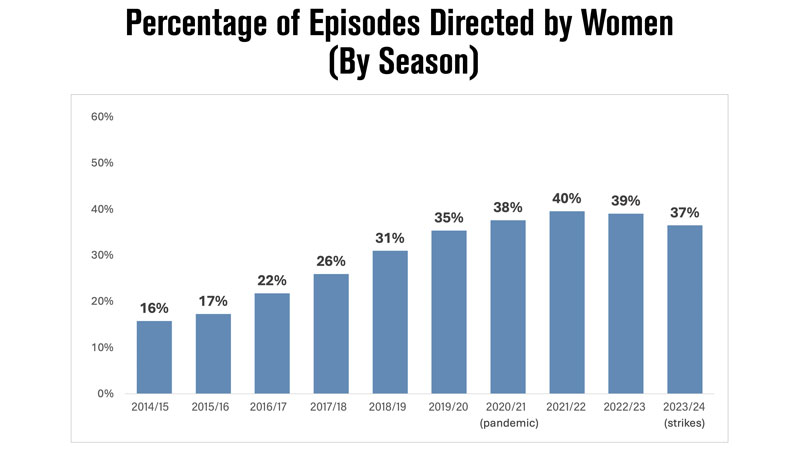
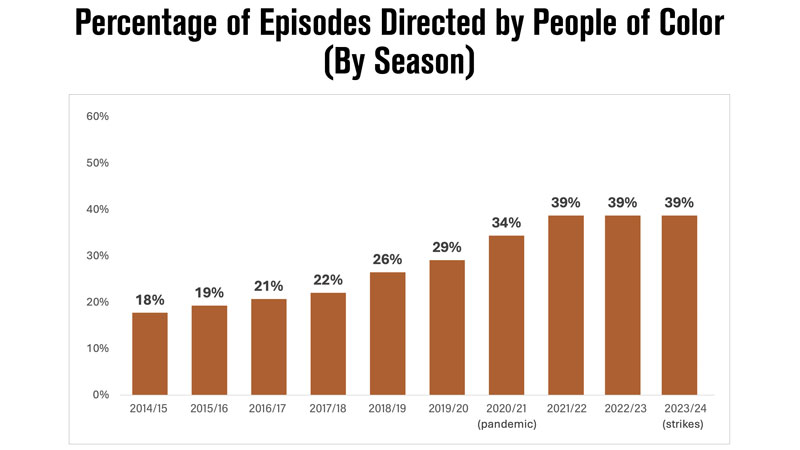
Hiring trends in specific communities since the 2014-2015 season showed the following: women of color grew from 3% in 2014/15 to 13% in 2023/24. Men of color increased from 15% in 2014/15 to 26% in 2023/24, and representation for white women expanded from 13% in 2014/15 to 20% in 2023/24.
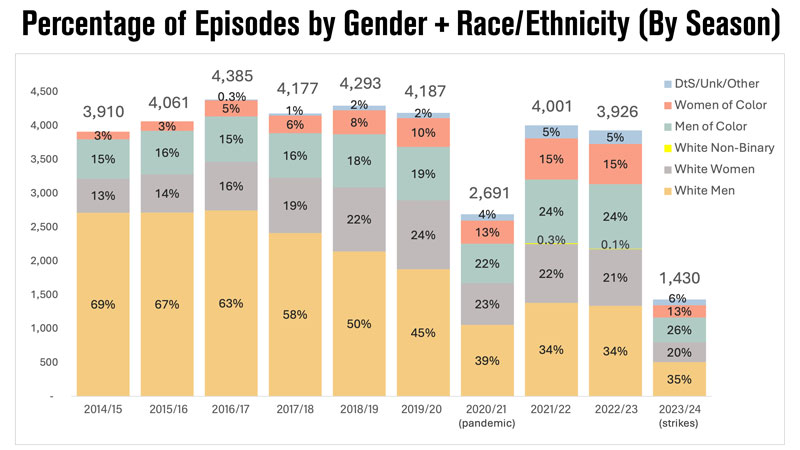
The report also shows that despite the strike-related drop in episodic television production in 2023/24 – 1,430 episodes compared to 3,926 in 2022 – hiring across six of seven demographic categories remained proportionate to prior years.
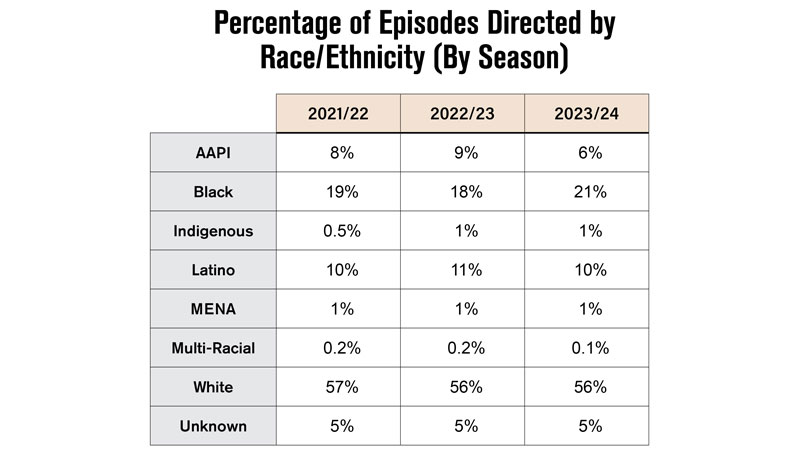
To expand its research into the diversity of hiring the television industry, the DGA began tracking data of episodic television Directors who self-identity as members of the LBGTQ+ and disabled communities. Its inaugural data shows that of episodes produced in 2023, 8.6% were directed by members of the LGBTQ+ community and 0.6% by a member of the disabled community.
“We encourage the studios to continue to build on the progress they have made over the prior decade as production levels recover following various disruptions to work over the last few years,” said Edward Ornelas, co-chair of the DGA’s Television Diversity Task Force. “We are particularly focused on finding ways to increase behind the camera representation for the Latino community, which continues to lag despite its status as a large historically marginalized group.”
Hiring of the Directorial Team
Over the 2023-2024 season, a total of 660 full-season hires (not individuals hired for just a day or few days on an individual episode) were made for directorial teams in episodic television, including First Assistant Directors (First ADs), Second Assistant Directors (Second ADs), and Unit Production Managers (UPMs), all working under weekly deal memos on projects primarily shot in the United States.
Overall gender and ethnic diversity hiring at the directorial team level has remained consistent since the DGA began tracking data during the 2020-2021 season and stayed proportional to production during the strikes. For women members of the directorial team, hiring in the 2023-2024 season was 41%, and for the race and ethnicity, 21% of Directors were from communities of color.
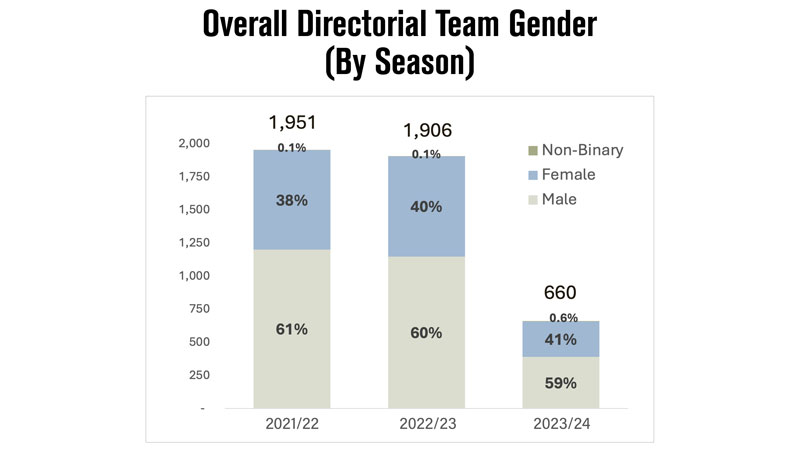
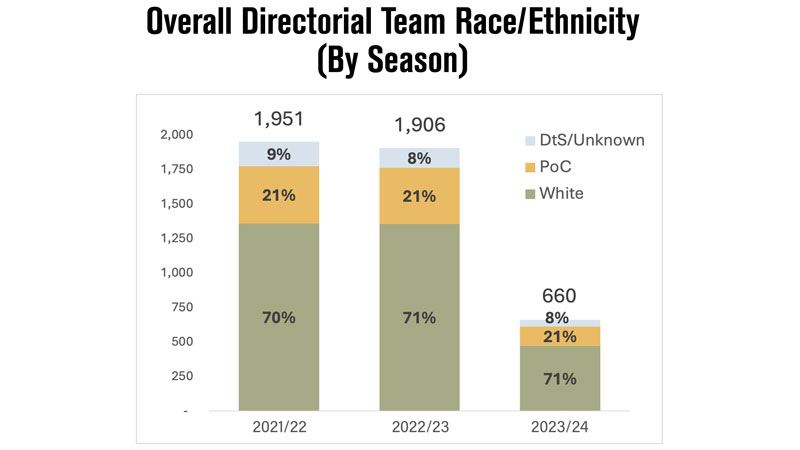
“The diversity of directorial teams working in episodic television remains low, especially when compared to hiring gains for episodic Directors,” said Heidi McGowen, a UPM member who serves on the Television Diversity Task Force. “To foster a profession that truly reflects a wide range of perspectives, studios must prioritize increasing inclusion at every level. The DGA is committed to creating pathways that expand employment opportunities for underrepresented members of directorial teams."
DGA Diversity Efforts
At the DGA, we believe storytelling should be as diverse as the world around us, and that a critical mass of different perspectives on screen is vital for the wellbeing and development of society. We’re committed to realizing the vision of a diverse and inclusive industry and have worked toward this goal for decades. Although the DGA has no authority over Director hiring, we seek to wield our influence and utilize our collective bargaining power, relationships, and resources to try to change industry practices. Currently, we employ a four-pronged approach to advance the issue: (1) engage with industry decision-makers; (2) negotiate with employers; (3) develop networking, career enhancement and training opportunities; and (4) report back to the industry.
For more information about the DGA’s diversity efforts, CLICK HERE.
APPENDIX: Directorial Team Job Category Data for the 2023-2024 Season
Women representation among directorial team employment categories was as follows:
- First AD female representation was 31%
- Second AD female representation was 51%
- UPM female representation was 43%
Racial and ethnic diversity in directorial team employment categories was as follows:
- First AD racial and ethnic diversity was 23%
- Second AD racial and ethnic diversity was 21%
- UPM racial and ethnic diversity was 18%
Representation from the LGBTQ+ community in directorial team employment was as follows:
- First AD LGBTQ+ representation was 3%
- Second AD LGBTQ+ representation was 5%
- UPM LGBTQ+ representation was 6%
Representation from the disabled community in the directorial team was as follows:
- There were no members of the disabled community hired as a First AD
- There was one member of the disabled community hired as a Second AD
- There were no members of the disabled community hired as a UPM
Hiring among gender and race/ethnicity in the directorial work categories was as follows:
- First ADs:
- White Women: 22%
- Non-Binary White: 0.8%
- Men of Color: 15%
- Women of Color: 8%
- Non-Binary Person of Color: 0%
- Unknown/Not Disclosed: 8%
- Second ADs:
- White Women: 34%
- Non-Binary White: 0.5%
- Men of Color: 5%
- Women of Color: 15%
- Non-Binary Person of Color: 0.5%
- Unknown/Not Disclosed: 6%
- UPMs:
- White Women: 32%
- Non-Binary White: 0%
- Men of Color: 9%
- Women of Color: 10%
- Non-Binary Person of Color: 0%
- Unknown/Not Disclosed: 9%

